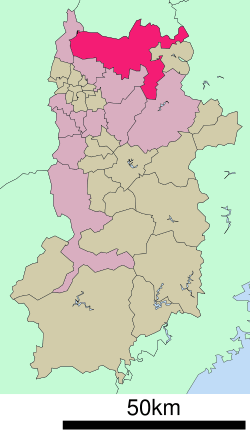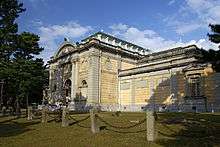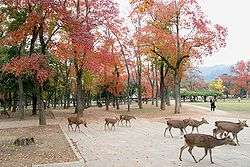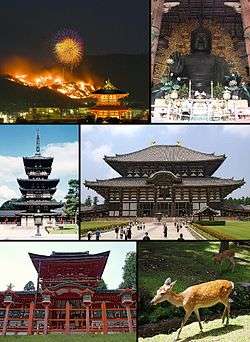Nara, Nara
| Nara 奈良市 | ||
|---|---|---|
| Core city | ||
| Nara City | ||
|
From top left: Wakakusayama Mountain Burning, Great Buddha of Tōdai-ji, Yakushi-ji, Tōdai-ji, Kasuga Shrine and a deer in Nara Park | ||
| ||
 Location of Nara in Nara Prefecture | ||
 Nara Location in Japan | ||
| Coordinates: 34°41′N 135°48′E / 34.683°N 135.800°ECoordinates: 34°41′N 135°48′E / 34.683°N 135.800°E | ||
| Country | Japan | |
| Region | Kansai | |
| Prefecture | Nara Prefecture | |
| Government | ||
| • Mayor | Gen Nakagawa | |
| Area | ||
| • Total | 276.84 km2 (106.89 sq mi) | |
| Population (January 1, 2010) | ||
| • Total | 368,636 | |
| • Density | 1,331.58/km2 (3,448.8/sq mi) | |
| Symbols | ||
| • Tree | Quercus gilva | |
| • Flower | Nara yaezakura | |
| • Bird | Japanese bush warbler | |
| Time zone | Japan Standard Time (UTC+9) | |
| City hall address |
1-1-1 Nijō-ōji, Nara-shi, Nara-ken 630-8580 | |
| Website |
www | |
Nara (奈良市 Nara-shi) is the capital city of Nara Prefecture located in the Kansai region of Japan. The city occupies the northern part of Nara Prefecture, bordering Kyoto Prefecture. Eight temples, shrines and ruins in Nara remain: specifically Tōdai-ji, Saidai-ji, Kōfuku-ji, Kasuga Shrine, Gangō-ji, Yakushi-ji, Tōshōdai-ji, and the Heijō Palace, together with Kasugayama Primeval Forest, collectively form "Historic Monuments of Ancient Nara", a UNESCO World Heritage Site.
Etymology
By the Heian period, a variety of different characters had been used to represent the name Nara: 乃楽, 乃羅, 平, 平城, 名良, 奈良, 奈羅, 常, 那良, 那楽, 那羅, 楢, 諾良, 諾楽, 寧, 寧楽 and 儺羅.
A number of theories for the origin of the name Nara have been proposed, and some of the better-known ones are listed here. The second theory in the list, by notable folklorist Kunio Yanagita (1875-1962), is most widely accepted at present.
- The Nihon shoki (The Chronicles of Japan, the second oldest book of classical Japanese history) suggests that "Nara" was derived from narasu (to flatten, to level). According to this account, in September in the tenth year of Emperor Sujin, "...leading selected soldiers (the rebels) went forward, climbed Nara-yama (hills lying to the north of Heijō-kyō) and put them in order. Now the imperial forces gathered and flattened trees and plants. Therefore the mountain is called Nara-yama." Though the narrative itself is regarded as a folk etymology and few researchers regard it as historical, this is the oldest surviving suggestion, and is linguistically similar to the following theory by Yanagita.
- "Flat land" theory (currently most widely accepted): In his 1936 study of placenames,[1] the author Kunio Yanagita states that "the topographical feature of an area of relatively gentle gradient on the side of a mountain, which is called taira in eastern Japan and hae in the south of Kyushu, is called naru in the Chūgoku region and Shikoku (central Japan). This word gives rise to the verb narasu, adverb narashi, and adjective narushi." This is supported by entries in a dialect dictionary[2] for nouns referring to flat areas: naru (found in Aida District, Okayama Prefecture and Ketaka District, Tottori Prefecture) and naro (found in Kōchi Prefecture); and also by an adjective narui which is not standard Japanese, but is found all across central Japan, with meanings of "gentle", "gently sloping", or "easy". Yanagita further comments that the way in which the fact that so many of these placenames are written using the character 平 ("flat"), or other characters in which it is an element, demonstrates the validity of this theory. Citing a 1795 document, Inaba-shi (因幡志) from the province of Inaba, the eastern part of modern Tottori, as indicating the reading naruji for the word 平地 (standard reading heichi, meaning "level/flat ground/land/country, a plain"), Yanagita suggests that naruji would have been used as a common noun there until the modern period. Of course, the fact that historically "Nara" was also written 平 or 平城 as above is further support for this theory.
- The idea that Nara is derived from 楢 nara (Japanese for "oak, deciduous Quercus spp.") is the next most common opinion. This idea was suggested by a linguist, Yoshida Togo.[3] This noun for the plant can be seen as early as in Man'yōshū (7-8th century) and Harima-no-kuni Fudoki (715). The latter book states the place name Narahara in Harima (around present-day Kasai) derives from this nara tree, which might support Yoshida's theory. Note that the name of the nearby city of Kashihara (literally "live oak plain") contains a semantically similar morpheme (Japanese 橿 kashi "live oak, evergreen Quercus spp.").
- Then, there is the idea that Nara is a loan word from Korean nara (나라 : country, nation, kingdom). This idea was put forward by a linguist Matsuoka Shizuo.[4] However, almost nothing about the Old Korean language is known today. The first written attestation of a word ancestral to Modern Korean nara is as late as the 15th century, such as in Yongbieocheonga(1447),[5] Wolinseokbo (月印釋譜. 1459), or Beophwagyeongeonhae (法華經諺解. 1463),[6] and there is no evidence that proves the word already existed as far back as the 7th century. These 15th-century books used narah (나랗), an old form of nara in Korean, and its older form might be reconstructed *narak. American linguist Christopher I. Beckwith infers the Korean narak derives from the late Middle Old Chinese 壌 (*nrak, earth), from early *narak, and has no connection with Goguryoic and Japanese na.[7] (See also the next theory.) Kusuhara et al. also points out this hypothesis cannot account for the fact there are lots of places named Nara, Naru and Naro besides this Nara.[8]
- There is the idea that Nara is akin to Tungusic na.[9] In some Tungusic languages such as Orok (and likely Goguryeo language), na means earth, land or the like. Some have speculated about a connection between these Tungusic words and Old Japanese nawi, an archaic and somewhat obscure word that appears in the verb phrases nawi furu and nawi yoru ('an earthquake occurs, to have an earthquake').[10]
The "Flat land" theory is adopted by Nihon Kokugo Daijiten (the largest dictionary of Japanese language), various dictionaries for place names,[8][11][12] history books on Nara[13] and the like today, and it is regarded as the most likely.
History
Nara was the capital of Japan from 710 to 794, lending its name to the Nara period.
The temples of Nara, known collectively as the Nanto Shichi Daiji, remained powerful even beyond the move of the political capital to Heian-kyō in 794, thus giving Nara a synonym of Nanto (南都 "The southern Capital").
In 2010, Nara celebrated the 1,300th anniversary of its ascension as Japan's imperial capital.[14]
Modern Nara
In the modern age, as the seat of the prefectural government, Nara has developed into a local center of commerce and government. The city was officially incorporated on February 1, 1898.
Geography
The city of Nara lies in the north end of Nara Prefecture, directly bordering itself to Kyoto Prefecture in its north side. The city is 22.22 kilometres (13.81 mi) from North to South, from East to West. As a result of the latest merger, effective April 1, 2005, that combined the villages of Tsuge and Tsukigase with the city of Nara, the city now borders Mie Prefecture directly to its east. The total area is 276.84 square kilometres (106.89 square miles).[15]
The downtown of Nara is on the east side of the ancient Heijō Palace site, occupying the northern part of what was called the Gekyō (外京), literally the outer capital area. Many of the public offices (e.g. the Municipal office, the Nara Prefectural government, the Nara Police headquarters, etc.) are located on Nijō-ōji (二条大路), while Nara branch offices of major nationwide banks are on Sanjō-ōji (三条大路), with both avenues running east-west.
The highest point in the city is at the peak of Kaigahira-yama at an altitude of 822.0 m (2,696.85 ft) (Tsugehayama-cho district), and the lowest is in Ikeda-cho district, with an altitude of 56.4 m (185.04 ft).[16]
Climate
The climate of Nara Prefecture is generally temperate, although there are notable differences between the north-western basin area and the rest of the prefecture which is more mountainous.
The basin area climate has an inland characteristic, as represented in the higher daily temperature variance, and the difference between summer and winter temperatures. Winter temperatures average approximately 3 to 5 °C (37 to 41 °F), and from 25 to 28 °C (77 to 82 °F) in the summer with highest readings reaching close to 35 °C (95 °F). There has not been a single year since 1990 with more than 10 days of snowfall recorded by Nara Local Meteorological Observatory.
The climate in the rest of the prefecture is that of higher elevations especially in the south, with −5 °C (23 °F) being the extreme minimum in winter. Heavy rainfall is often observed in summer. The annual accumulated rainfall totals as much as 3,000 to 5,000 mm (118.11 to 196.85 in), which is among the heaviest in Japan and indeed in the world outside the equatorial zone.
Spring and fall temperatures are temperate and comfortable. The mountainous region of Yoshino has been long popular for viewing cherry blossoms in the spring. In autumn, the southern mountains are also a popular destination for viewing fall foliage.
| Climate data for Nara, Nara (1981~2010) | |||||||||||||
|---|---|---|---|---|---|---|---|---|---|---|---|---|---|
| Month | Jan | Feb | Mar | Apr | May | Jun | Jul | Aug | Sep | Oct | Nov | Dec | Year |
| Record high °C (°F) | 18.9 (66) |
23.9 (75) |
25.9 (78.6) |
30.5 (86.9) |
32.7 (90.9) |
35.8 (96.4) |
37.3 (99.1) |
39.3 (102.7) |
36.9 (98.4) |
32.0 (89.6) |
26.8 (80.2) |
21.7 (71.1) |
39.3 (102.7) |
| Average high °C (°F) | 8.7 (47.7) |
9.6 (49.3) |
13.4 (56.1) |
19.8 (67.6) |
24.1 (75.4) |
27.2 (81) |
30.8 (87.4) |
32.6 (90.7) |
28.2 (82.8) |
22.2 (72) |
16.5 (61.7) |
11.4 (52.5) |
20.4 (68.7) |
| Average low °C (°F) | −0.2 (31.6) |
−0.1 (31.8) |
2.3 (36.1) |
7.4 (45.3) |
12.5 (54.5) |
17.5 (63.5) |
21.8 (71.2) |
22.6 (72.7) |
18.8 (65.8) |
12.1 (53.8) |
6.4 (43.5) |
1.9 (35.4) |
10.3 (50.5) |
| Record low °C (°F) | −7 (19) |
−7.8 (18) |
−5 (23) |
−2.4 (27.7) |
1.4 (34.5) |
7.3 (45.1) |
12.2 (54) |
12.8 (55) |
7.7 (45.9) |
2.3 (36.1) |
−2.6 (27.3) |
−6.6 (20.1) |
−7.8 (18) |
| Average precipitation mm (inches) | 49.6 (1.953) |
63.3 (2.492) |
103.2 (4.063) |
97.7 (3.846) |
143.5 (5.65) |
188.8 (7.433) |
165.1 (6.5) |
111.8 (4.402) |
163.3 (6.429) |
111.1 (4.374) |
71.4 (2.811) |
47.3 (1.862) |
1,316.1 (51.815) |
| Average snowfall cm (inches) | 2 (0.8) |
4 (1.6) |
1 (0.4) |
0 (0) |
0 (0) |
0 (0) |
0 (0) |
0 (0) |
0 (0) |
0 (0) |
0 (0) |
1 (0.4) |
8 (3.1) |
| Average precipitation days (≥ 0.5 mm) | 7.9 | 7.9 | 12.3 | 10.6 | 11.3 | 12.9 | 11.8 | 8.6 | 11.5 | 9.8 | 8.3 | 7.7 | 120.6 |
| Average snowy days | 1.4 | 1.9 | 0.8 | 0.0 | 0.0 | 0.0 | 0.0 | 0.0 | 0.0 | 0.0 | 0.0 | 0.7 | 4.8 |
| Average relative humidity (%) | 69 | 69 | 68 | 65 | 69 | 75 | 77 | 74 | 77 | 77 | 76 | 72 | 72.3 |
| Mean monthly sunshine hours | 116.7 | 115.5 | 147.4 | 180.3 | 184.8 | 143.5 | 162.7 | 205.4 | 150.3 | 154.5 | 134.5 | 127.3 | 1,822.9 |
| Source #1: Japan Meteorological Agency[17] | |||||||||||||
| Source #2: Japan Meteorological Agency (records)[18] | |||||||||||||
Demographics
As of 2005, the city has an estimated population of 373,189 and a population density of 1,348 persons per km2. There were 147,966 households residing in Nara. The highest concentration of both households and population, respectively about 46,000 and 125,000, is found along the newer bedtown districts, along the Kintetsu line connecting to Osaka.
There were about 3,000 registered foreigners in the city, of which Koreans and Chinese are the two largest groups with about 1,200 and 800 people respectively.
Landmarks
| Historic Monuments of Ancient Nara | |
|---|---|
| Name as inscribed on the World Heritage List | |
| Type | Cultural |
| Criteria | ii, iii, iv, vi |
| Reference | 870 |
| UNESCO region | Asia-Pacific |
| Inscription history | |
| Inscription | 1998 (22nd Session) |
- Kofun
- Gosashi tomb
- Saki Ishidukayama tomb
- Saki Misasakiyama tomb
- Hishiage tomb
- Konabe tomb
- Uwanabe tomb
- Horaisan tomb
- Buddhist temples
- Shinto shrines
- Former imperial palace
- Others
- Kasugayama Primeval Forest
- Naramachi
- Nara National Museum
- Nara Park
- Nara Hotel
- Isuien Garden
- Sarusawa Pond
- Mount Wakakusa
- Yagyū
 Gosashi tomb
Gosashi tomb Tōdai-ji Temple Daibutsuden Hall, the world's largest wooden building
Tōdai-ji Temple Daibutsuden Hall, the world's largest wooden building Kōfuku-ji in the center of Nara
Kōfuku-ji in the center of Nara

- Isuien Garden stepping stones

Deer in Nara

According to the legendary history of Kasuga Shrine, a mythological god Takemikazuchi arrived in Nara on a white deer to guard the newly built capital of Heijō-kyō.[19] Since then the deer have been regarded as heavenly animals, protecting the city and the country.[19]
Tame sika deer (also known as spotted deer or Japanese deer) roam through the town, especially in Nara Park.[15][16][20][21][22] In 2015 there were more than 1,200 sika deer in Nara.[20][21][22] Snack vendors sell sika senbei (deer crackers) to visitors so they can feed the deer.[20][21][22] Some deer have learned to bow to people after receiving senbei.[20][21][22]
Education
As of 2005, there are 16 high schools and 6 universities located in the city of Nara.
Universities
Nara Women's University is one of only two national women's universities in Japan.
Primary and secondary education
Public schools
Public elementary and junior high schools are operated by the city of Nara.
Public high schools are operated by the Nara Prefecture.
Private schools
Private high schools in Nara include the Tōdaiji Gakuen, a private school founded by the temple in 1926.
Transportation
The main central station of Nara is Kintetsu Nara Station.
Rail
- West Japan Railway Company
- Kansai Main Line (Yamatoji Line): Narayama Station - Nara Station
- Sakurai Line (Manyō-Mahoroba Line): Nara Station - Kyōbate Station - Obitoke Station
- Kintetsu Railway
- Nara Line: Tomio Station - Gakuen-mae Station - Ayameike Station - Yamato-Saidaiji Station - Shin-Ōmiya Station - Kintetsu Nara Station
- Kyoto Line: Takanohara Station - Heijō Station - Yamato-Saidaiji Station
- Kashihara Line: Yamato-Saidaiji Station - Amagatsuji Station - Nishinokyō Station
- Keihanna Line: Gakken Nara-Tomigaoka Station
Roads
- Expressways
- Keinawa Expressway (Under construction)
- Hanshin Expressway Dainihanna Route
 Japan National Route 24
Japan National Route 24 Japan National Route 25
Japan National Route 25 Japan National Route 169
Japan National Route 169 Japan National Route 308
Japan National Route 308 Japan National Route 369
Japan National Route 369 Japan National Route 370
Japan National Route 370
International relations
Twin towns/sister cities
Nara, according to its own official record, has three sister cities in Japan and six sister cities overseas.[23][24]
In Japan
Outside Japan
 Canberra, Australia[25]
Canberra, Australia[25] Gyeongju, Korea
Gyeongju, Korea Toledo, Castile-La Mancha, Spain
Toledo, Castile-La Mancha, Spain Versailles, France
Versailles, France Xi'an, China
Xi'an, China Yangzhou, China
Yangzhou, China
Cultural References
In Alt-J's 2014 album, This is All Yours, 3 tracks reference Nara - "Arrival in Nara", "Nara", and "Leaving Nara".[26]
References
- ↑ 柳田国男 (Yanagita, Kunio) (1936): 地名の研究 (The Study of Place Names), pub. 古今書院 (Kokon Shoin), pp. 217-219
- ↑ 東条 操 (Tōjō, Misao) (1951): 全国方言辞典 Dictionary of Japanese Dialects, 東京堂出版.
- ↑ 吉田東伍 YOSHIDA Tōgo (1907), 『大日本地名辞書 上巻』 (The Dictionary of Place Names in the Great Japan, Fuzambo, Vol.1), 冨山房, pp.190-191.
- ↑ 松岡静雄 編 MATSUOKA Shizuo ed. (1929), 『日本古語大辞典』 (The Unabridged Dictionary of Old Japanese), 刀江書院, p.955. Previous to Matsuoka, KANAZAWA Shôzaburô (1903) pointed out the possibility of influence from Korea. Both were, however, comparing Old Japanese to Modern Korean, not Old Korean.
- ↑ NAVAR Korean Dictionary
- ↑ 劉昌惇 (1964), 李朝語辭典 (The Dictionary of Words in the Joseon Dynasty), 延世大学校出版部.
- ↑ Beckwith (2007): Koguryo, the Language of Japan's Continental Relatives, Brill Academic Publishers, 2004. 2nd ed., 2007. p.176
- 1 2 楠原佑介ほか KUSUHARA Yūsuke et al. (1981), 『古代地名語源辞典』 (The Dictionary of Ancient Place Name Etymology), 東京堂出版, p.232
- ↑ One of the earliest assumption for this is seen in 奈良市 編 Nara ed. (1937), 『奈良市史』 (The History of Nara, Nara)., 奈良市.
- ↑ 宮腰賢ほか編 MIYAKOSHI Masaru et al. ed. (2011), 『全訳古語辞典』 (The Dictionary of Old Japanese with Complete Translation) 第4版, 旺文社.
- ↑ 池田末則・横田健一編 IKEDA Suenori & YOKOTA Ken'ichi (Eds.) (1981), 『日本歴史地名大系30 奈良県の地名』(A Series on Historical Place Names in Japan, Vol. 30, Place Names in Nara Prefecture), 平凡社, p.490
- ↑ 角川日本地名大辞典編纂委員会編 (1990), 『角川日本地名大辞典 29 奈良県』(Kadokawa Unabridged Dictionary of Place Names in Japan, Vol. 29, Nara Prefecture), 角川書店, p.814
- ↑ e.g. 斎藤建夫 編 SAITŌ Tateo (ed.) (1997), 『郷土資料事典 : ふるさとの文化遺産. 29(奈良県) 』 (The Dictionary of Native Place Data. Vol. 29. Nara Prefecture.), 人文社, p.27
- ↑ Tabuchi, Hiroko (2010-01-03). "Happy 1,300th to Nara, Japan". The New York Times. Retrieved 2010-05-19.
- 1 2 "City Profile of Nara". Nara City. 2007-04-02. Retrieved 2007-04-02. For more details and latest figures, navigate to the equivalent Japanese page at the official homepage
- 1 2 "奈良市統計書「統計なら」平成17年版(2005年版)(Nara City Statistics, Year 2005 Edition)" (in Japanese). Retrieved 2007-04-02.
- ↑ "平年値(年・月ごとの値)". Japan Meteorological Agency. Retrieved 2011-10-22.
- ↑ "観測史上1~10位の値(年間を通じての値)". Japan Meteorological Agency. Retrieved 2011-10-22.
- 1 2 "奈良のシカの歴史 (The history of deer in Nara)" (in Japanese). Retrieved 2007-04-02.
- 1 2 3 4 "In Nara, Japan, the deer know their place: everywhere". Los Angeles Times. 2010-04-02.
- 1 2 3 4 "Oh, deer! Take the cutest selfie at Japan's Nara Park". The Globe and Mail. 2015-10-08.
- 1 2 3 4 "Are There Really Deer Everywhere In Nara Park?". Matcha. 2015-04-04.
- ↑ http://www.city.nara.nara.jp/b_hp/english/kokon/kuryu/index.htm
- ↑ Vladimir, Russia recognizes Nara as one of its sister cities, while Nara does not.Sister cities of Vladimir
- ↑ "Canberra's international relationships - Canberra's international relationships". www.cmd.act.gov.au. Retrieved 2009-10-20.
- ↑ "Alt-J: This Is All Yours (review)". Pitchfork. Retrieved 2016-04-04.
External links
| Wikimedia Commons has media related to Nara, Nara. |
 Nara travel guide from Wikivoyage
Nara travel guide from Wikivoyage- Nara City official website

